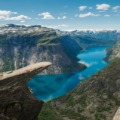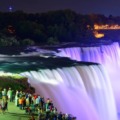Denmark boasts a captivating blend of history, innovation, and natural beauty. Renowned for its progressive social policies, picturesque landscapes, and bicycle-friendly cities, Denmark effortlessly merges old-world charm with modernity. From the vibrant streets of Copenhagen, its capital city adorned with colorful buildings and a bustling harbor, to the serene countryside adorned with windmills and coastal wonders, Denmark offers a delightful tapestry of experiences. Home to fairy-tale castles like Kronborg and Frederiksborg, as well as the iconic statue of The Little Mermaid, Denmark captivates visitors with its rich heritage, delectable culinary delights, and the inviting warmth of its people, making it a treasure trove of both history and contemporary allure.
Copenhagen
 Rosenborg Castle, the Kings Garden. kn/shutterstock |
Copenhagen, the enchanting capital of Denmark, exudes a vibrant cosmopolitan charm while retaining its distinct Scandinavian character. Nestled along the coastal islands of Zealand and Amager, this city harmoniously blends historic grandeur with modern innovation. From the iconic Nyhavn harbor, adorned with colorful buildings and lively waterfront cafes, to the architectural marvel of the Royal Danish Opera House and the cutting-edge design of the Black Diamond, Copenhagen seamlessly fuses tradition and contemporary style. .
Elsinore Castle

neuartelena/shutterstock
Elsinore Castle, also known as Kronborg Castle, stands as an emblematic fortress at the northeastern tip of the island of Zealand. Renowned worldwide as the setting for William Shakespeare’s renowned play, “Hamlet,” this UNESCO World Heritage Site emanates a profound historical aura and architectural splendor. Its imposing Renaissance structure, characterized by robust towers and majestic halls, overlooks the Øresund Strait, commanding a strategic position for centuries as a vital stronghold for Denmark’s maritime control. Beyond its literary association, Elsinore Castle enchants visitors with its rich tapestry of chambers, ballrooms, and the impressive casemates.
Jelling Rune Stones

bmj/shutterstock
The Jelling Rune Stones, situated in the small town of Jelling, hold an exceptional historical significance as enduring markers of Viking Age culture and the transition to Christianity in Scandinavia. These two massive runestones, known as the Harald Stone and the Gorm Stone, stand proudly in the Jelling complex, flanking a grand burial mound. Crafted in the 10th century, these stones bear inscriptions and intricate carvings that symbolize a pivotal moment in Danish history—the conversion of Denmark to Christianity and the unification of the country under King Harald Bluetooth.
Frederiksborg Castle

irina-korshunova/shutterstock
Frederiksborg Castle, situated in the landscapes of Hillerød is a masterpiece of architecture. Built in the early 17th century by King Christian IV, it is surrounded by a tranquil lake and immaculate gardens. The castle houses the captivating Museum of National History, showcasing a treasure trove of royal art, portraiture, and historical artifacts that narrate Denmark’s rich cultural heritage. The castle’s sumptuous Great Hall, adorned with intricate ceiling paintings, and the Baroque-style Chapel resonate with grandeur, while the expansive grounds and cascading fountains create an enchanting atmosphere.
Egeskov Castle

willem-dijkstra/shutterstock
Egeskov Castle is an enchanting Renaissance water castle situated in the picturesque countryside of Funen. Dating back to the 16th century, this moated castle is a masterpiece of engineering and is surrounded by lush gardens, serene lakes, and verdant forests. Its well-preserved turrets, winding staircases, and elaborately decorated rooms offer visitors a glimpse into centuries of Danish history and noble life.
Mons Klint

josef-f.-stuefer/shutterstock
Møns Klint, an awe-inspiring natural wonder located along the eastern coast of the island of Møn, captivates visitors with its breathtaking beauty and geological significance. Towering chalk cliffs, reaching heights of up to 128 meters above the Baltic Sea, create a mesmerizing panorama of striking white cliffs contrasted against the azure waters below. These cliffs, adorned with fossil-rich layers, represent millions of years of geological history, offering a glimpse into the Earth’s ancient past.
Faroe Islands
 Gasadalur Waterfall. galyna-andrushko/shutterstock |
The Faroe Islands, a captivating archipelago nestled in the North Atlantic between Norway and Iceland, offer a breathtaking tapestry of dramatic landscapes, rugged cliffs, and picturesque villages. Comprising 18 rocky islands, each adorned with soaring sea cliffs, green valleys, and cascading waterfalls, the Faroes present an untouched paradise for nature enthusiasts and adventurers alike. The islands’ remote charm and unspoiled beauty are enhanced by the ever-changing weather that shrouds these lands in mist and sunlight, creating a mystical ambiance.




